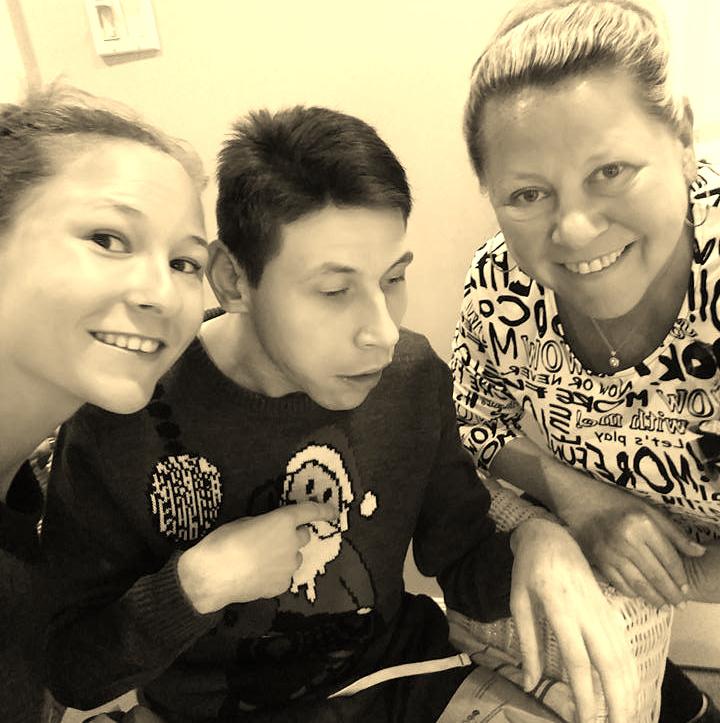
Cat Delaney
Dec. 8, 2017, 6:37 p.m.

In honor of International Day of Persons with Disabilities, I’d like to share with you the story of someone very important to me and why I recognize not only this day, but every other day, as a day to celebrate the inclusion of persons with disabilities. I must preface this blog with a “bear with me” as I am quite passionate about this subject and indebted to its content.
My brother was born with Cerebral Palsy.
For those who are unaware, CP is a neurological disorder that is very hard to place on a definitive spectrum but is generally defined as a malformation that occurs during the early stages of development that can affect both body movement and muscle coordination. In my brother’s case, doctors expressed that he might never be able to walk, talk, express himself or maintain a healthy weight due to inactivity. He, however, is now 27 years old, and though he may have the mental capacity of a 3 year old, his abilities have amounted to more than what doctors had predicted. He wears a diaper, can say a few words and count to ten, needs some assistance to walk because of muscular and bone development issues, and is certainly not overweight. And, on top of all that, I must say that he is seemingly the happiest person I know!
I cannot continue my story without briefing you on what the journey has been like for my mom and I, as we have participated in my brother’s development and life transitions. For some time now, my brother has been living in “group homes.” Why? Well, it was hard for my mom as a single, working parent. From a young age, my brother has had a stringent medication schedule, and has had the need to be frequently exercised so as to avoid bone breakage and muscle deterioration. He needed someone there at all times and my mom wasn’t able to be that person. She owned her own business, had a second child in school and struggled as is to attend to her own needs and self-care. What people often don’t understand about families and parents with children with disabilities, is that it is extremely difficult to navigate your child’s day-to-day experiences while ensuring that their care is optimal and beneficial to them. The truth is, my mom needed support and group homes gave her the reassurance that my brother was in the best care and attended to by professionals with only his best interests in mind.
My brother began living in his “childhood home” at an age that I can’t even recall, and remained there up until just a few years ago. This was his second home – his second family. There, his family consisted of other kids like him, his personal care workers, and supports who worked around the clock who acted as parental figures. The families of all the children in the home were connected with each other – we were a family of families per say. The kids all went to school together, participated in various activities together – all of this made for incredible social and physical strides in my brothers’ growth. Unfortunately, a time had come when those in charge decided that it was no longer acceptable for my brother to take up a space in a home – they said he was old enough and that, because he was no longer benefitting from the school system, that he should be transferred into a day program. He was bounced around from home to home, program to program – no one seemed to care what this was doing to him. It is only because of my mother, the advocate, that my brother has been able to assume a space in a group home to this day. My family saw the difference it made for my brother so it goes without saying that a group home was the best place for my brother to be.
My reasons for pursing an education and career in program/policy development stems a lot from the abovementioned circumstances and my family’s experience with group homes and similar organizations working to support individuals with disabilities. I genuinely believe that an evaluation needs to be done in regards to the functioning of group homes, the requirements to be met for clients to continue their residence, and also, our society as a whole. I believe there needs to be a more in depth understanding of the impact disability has on everyone affected by it and the importance of services and resources to fill in the gaps that families made not be able to.
In my opinion, two things need to change within these healthcare and community settings. The first is the treatment and management of those with disabilities. And the second, is the need to increase accessibility for this population. In reference to the former, there are a lot of people who don’t understand disability when they see it and thus, don’t know how to react to it when in its company. I can vividly recall childhood trips to the grocery store where my brother, in all his glory, would self-stim – he would make noises, rock back and forth, clap his hands and shake his head. These repetitive behaviours counteracted the overwhelming sensory environment and alleviated some of the excitement that my brother was experiencing. Of course, I knew this because it was my responsibility to become familiar with these behaviours. But as a child in a grocery store overhearing the snickering comments of other children asking “mommy what is wrong with him” and parents abruptly answering, “he just has a problem, don’t stare,” I was offended. Despite now knowing these comments were unlikely grounded in lack of respect, I still believe that there could have been a different way of responding, a way that shed light on the diversity of people and the need to refrain from casting judgement on those whose stories we do not know. Though I am not yet a parent and cannot speak to the demands of a child’s innocent inquiries, I do believe that parents have the responsibility to educate their children and instill in them, a sense of progressiveness and appreciation for those exhibiting qualities contrary to society’s norms.
Moving onto the second, there is undoubtedly a need for the city to update the physical environment of its businesses, storefronts and other localities. There should also be accessible bathrooms and change rooms in many more locations than there are. I’ve been lucky enough to speak with other individuals, and families supporting those, with Cerebral Palsy and other physical disabilities. And what I’ve found is that, in many settings, wheelchairs are not accommodated for and adult changing facilities are non-existent. I will never forget a story that I heard of someone needing to bring their wheel-chair bound sister across an entire park to use the bathroom before entering the pool facilities because there was no wheelchair ramp to, or changing tables in, the closest washroom. And, to top it off, there was no lift or ramp to assist her in entering the pool.
To conclude, I genuinely believe that there is a need to educate and develop a cultured understanding of what it means to have or live with someone with a disability. And, more societally, increase awareness of the programs, policies and societal structures that affect this population of individuals. With all of that being said, I’d like to leave you with a quote that has become near and dear to my heart and story
"Let us work together for the full and equal participation of persons with disabilities in an inclusive and sustainable world that embraces humanity in all its diversity." - Secretary-General Ban Ki-moon
Cat Delaney is a graduate from the University of Guelph with an honours degree in sociology and political science. She has always had an interest in human interaction and the ways in which policy or programs affect them. Her future aspirations include getting into a Master’s program for Critical Disability Studies, Public Service or Applied Politics and pursuing a career in institutional policy or program development to support those communities and individuals with disabilities. As someone with a family member with a severe disability, she has recognized the several ways institutions are deficient in their programing, and how organizations and companies can make changes to aid in accessibility and occupational safety.

May 15, 2018, 9:35 a.m.